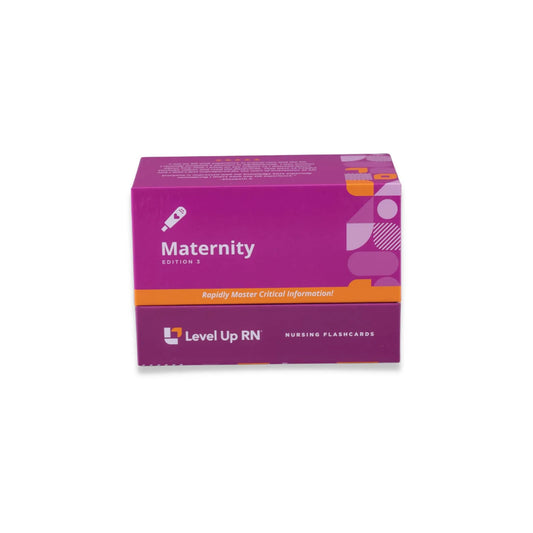Maternity Nursing - Flashcards
This article focuses on labor and complications that may occur during labor and delivery. We'll focus on external cephalic versions, Bishop scoring, and labor induction and augmentation. The Maternity Nursing series follows along with our Maternity Nursing Flashcards, which are intended to help RN and PN nursing students study for nursing school exams, including the ATI, HESI, and NCLEX.
 When you see this Cool Chicken, that indicates one of Cathy's silly mnemonics to help you remember. The Cool Chicken hints in these articles are just a taste of what's available across our Level Up RN Flashcards for nursing students!
When you see this Cool Chicken, that indicates one of Cathy's silly mnemonics to help you remember. The Cool Chicken hints in these articles are just a taste of what's available across our Level Up RN Flashcards for nursing students!
External cephalic version
External cephalic version is an ultrasound-guided procedure to turn a baby to the normal vertex presentation using external means. When broken into its elements, the term translates as: external, that is, outside of the patient; cephalic, referring to the baby's head; and [in]version, meaning, here, to twist or rotate. Essentially, rotating the baby's head from the outside of the patient.
This procedure is implemented when we have a patient who has a baby in a breech position, meaning their head is up and their feet are down, which is not the ideal position for labor. An external cephalic version attempts to rotate the baby so the baby's head is down and their feet are up — the vertex position.
What is the procedure for an external cephalic version?
The procedure for an external cephalic version involves applying pressure externally to rotate the fetus into a better (vertex) position for labor and delivery.
When and where should an external cephalic version be performed?
The external cephalic version procedure is performed at 37 weeks gestation. The procedure should never be attempted preterm because up until full term, there's still time for the baby to move around and get in the optimal position on its own. Also, the procedure could trigger preterm labor, which could have serious consequences for patient and child.
External cephalic version should be performed in a hospital, due to risk of complications. If, for example, the patient goes into labor as a result of the procedure, care is nearby, including the possibility of delivering the baby immediately.
Complications of external cephalic version
External cephalic version carries a number of risks, as the doctor or midwife is attempting to manipulate the contents of the patient's uterus, that is, the baby. This presents a high risk of umbilical cord compression and placental abruption.
Umbilical cord compression
Umbilical cord compression occurs when pressure is put on the umbilical cord. The umbilical cord carries nutrients and oxygen from the patient to the fetus. When the cord is compromised, this can lead to fetal malnourishment or oxygen deprivation. In the most serious cases, there is a risk of death to the fetus.
Placental abruption
Placental abruption is when the placenta is fully abrupted — separated — from the uterine wall.
External cephalic version nursing care
Administer IV fluids and tocolytics (medications used to suppress premature labor) to relax the uterus as ordered.
Continually monitor fetal heart rate (FHR) and maternal vital signs.
Administer rhogam to Rh-negative patients after the procedure, because of the potential for blood mixing and sensitization of the patient to fetal blood. It's important that the patient does not develop anti-Rh antibodies.
What is a Bishop score?
 I WISH my BISHop score would be high enough to induce labor!
I WISH my BISHop score would be high enough to induce labor!
A Bishop score is used to determine maternal readiness for labor induction based on cervical readiness. An assessment of the cervix is made to determine how close the patient is to labor and delivery.
What are the components of a Bishop score?
The components of a Bishop score are cervical consistency, cervical dilation, cervical effacement, cervical position, and station of presenting part.
How is the Bishop score affected by multiparous and nulliparous patients?
The patient's personal history also influences the score — a patient who is multiparous, meaning they have had babies before (“multi” meaning more than one; “parous” referring to delivery or birth) is going to be marked as being ready for labor induction with a score of 8 or higher.
A nulliparous patient (no prior deliveries) is going to require a score of 10 or higher to be considered ready for labor induction.
How is scoring done to get a Bishop score?
Cervical components are given scores ranging from 0 to 3, with the exceptions of position and station, which are given scores of 0 to 2. The higher the score, the more likely the situation is optimal for delivery. A lower score indicates a cervix that is not ready for delivery or labor induction.
Labor induction and augmentation
For labor induction and augmentation, we're going to focus on two methods — cervical ripening and amniotomy — as well as use of the medication oxytocin.
What is cervical ripening?
Cervical ripening is preparing the cervix for induction, that is, getting the cervix more ready for labor.
Cervical ripening involves procedures that promote cervical softening, dilation, and effacement. These can include the use of chemical agents and/or mechanical methods.
Chemical agents used in cervical ripening
Chemical agents used in cervical ripening include prostaglandins such as misoprostol (brand name Cytotec). Misoprostol is a medication that softens the cervix and helps it to dilate and efface. (Misoprostol is also indicated as an antiulcer agent. Note the black box warning for patients who might not know they are pregnant as misoprostol can induce a miscarriage.)
Nursing care for cervical ripening using prostaglandins
A risk when using prostaglandins is uterine tachysystole or uterine hyperstimulation. This is when the uterus becomes over-excited — contractions are either too strong or happening too frequently. This can put the patient at risk for uterine rupture. Taking the patient off prostaglandins is the first step if uterine tachysystole or uterine hyperstimulation is suspected.
When using prostaglandins, it is also important to monitor both FHR and the patient's contractions.
For more on labor-related and other pharmacology basics, check out our Pharmacology Second Edition Flashcards, which are intended to help RN and PN nursing students study for nursing school exams, including the ATI, HESI, and NCLEX.
Mechanical methods used in cervical ripening
Mechanical methods for cervical ripening include balloon catheters, dilators, and membrane stripping.
If you recall how a Foley catheter works, a balloon catheter functions similarly. The catheter is passed through the cervix, and then a balloon on the end of the catheter is slowly inflated to put pressure on the cervix from the middle (inside) to try to help it dilate.
Cervical dilators are used to gently widen the cervix and exert pressure. These actions stimulate the release of natural prostaglandins.
Membrane stripping is a procedure where the provider inserts a gloved finger into the patient's cervix and rubs or separates the membranes that connect the uterus and the amniotic sac. This technique releases natural prostaglandins and helps ripen the cervix.
What is amniotomy?
Amniotomy is the use of a sharp instrument to rupture amniotic membranes. This is an artificial means of causing the water to break in preparation for delivery. Remember, any sort of “-otomy” is a puncturing or laceration. An amniotomy is a laceration of the amnion (the membrane that forms a fluid-filled cavity (the amniotic sac) enclosing the embryo). In this procedure, a sharp instrument is used to poke a hole in the amniotic sac, rupturing the membranes.
Patient risk for an amniotomy
Whenever something from outside the body is introduced to the inside, there is a risk for infection (in this case, chorioamnionitis).
Also, when the amniotic membrane ruptures and the fluid shifts (when the waters break), there is a change in pressure — the barrier has been broken between the outside and the inside. This can present a risk of cord prolapse, if the cord is partially sucked out when the pressure changes as the membranes are ruptured.
Nursing care for amniotomy
Make sure to monitor FHR before and immediately after amniotomy for bradycardia and variable decelerations.
It is also important to ensure that the presenting part of the fetus is engaged prior to the amniotomy. An amniotomy is not performed without full engagement.
Because of the risk for infection, it is important to check the patient's temperature every two hours, or per facility policy, looking for any signs of infection after the amniotomy.
What is oxytocin?
Oxytocin is a hormone created by the body naturally during labor that increases the strength, frequency, and length of uterine contractions. It is also used to control postpartum bleeding by firming up the uterus after delivery.
Oxytocin can also be administered in a synthetic form through an IV to augment or to induce labor.
Nursing care when administering oxytocin
When administering oxytocin, it is important to continuously assess the status of the baby by monitoring FHR and the patient's contractions.
One risk of using oxytocin to augment the contractions is overstimulating the uterus, which, as noted above, could lead to uterine tachysystole. In the event of uterine tachysystole, discontinue the oxytocin.
Additionally, discontinue oxytocin:
- If contractions occur more than every two minutes
- If contractions last longer than 90 seconds
- If contractions have an intensity greater than 90 millimeters of mercury using an intrauterine pressure catheter
- If, during a resting tone (meaning when the uterus is not contracting), that resting tone is greater than 20 mm millimeters of mercury between contractions
Essentially, discontinue oxytocin if the contractions are happening too frequently, if they're lasting too long, if their strength is too high, or if the resting tone is too high.
Another way to calm a hyperstimulated uterus is to administer terbutaline. Terbutaline is a tocolytic, which is used to help to relax the uterus.
Also notify the provider.


